A New Opera
V4 revolution
The Panigale V4 replaces the iconic 1299 at the top of the Ducati supersport range, doing so by enhancing performance and ridability so that riders of all skill levels can enjoy boundless fun and excitement. The Panigale V4 has been developed in close collaboration with Ducati Corse, drawing directly on know-how and technology from the racing world to provide a road bike that is the closest thing possible to its MotoGP counterpart.
CONCEPT
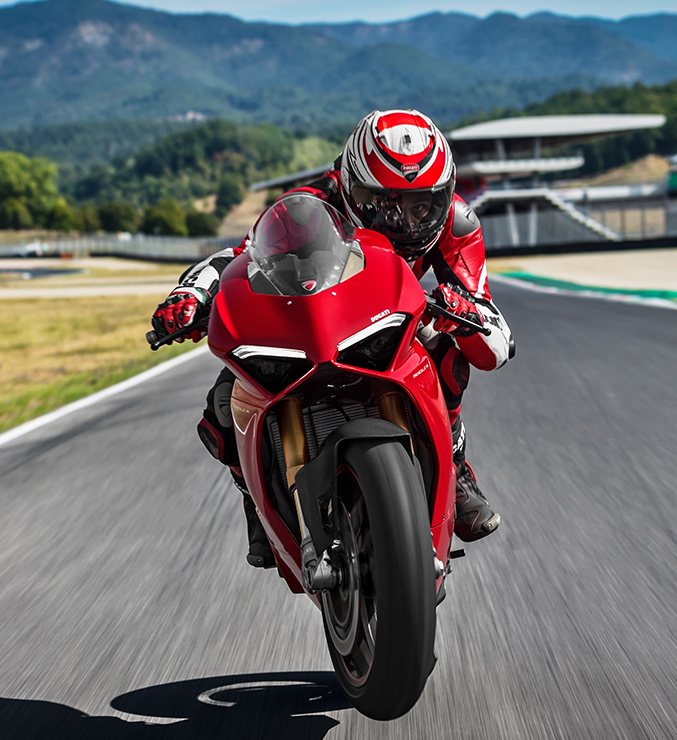 A new paradigm;
A new paradigm;The new Panigale V4 is the essence of sport motorcycling in its most exhilarating and pure form: redefined design, new engine, state-of-the-art chassis and innovative electronics. A concentrated blend of Ducati technology, style and performance
DESIGN
 The character has taken shape;Elegant, muscular, technological. This is the essence of the style of the new Panigale V4. The Ducati Style Centre gave shape to the character of the bike and its performance following what for Ducati are the canons of Italian sports elegance: large and soft surfaces interrupted by few bold marks. Component integration, the idea of power and functionality have become dominant elements of the style and of the whole project.
The character has taken shape;Elegant, muscular, technological. This is the essence of the style of the new Panigale V4. The Ducati Style Centre gave shape to the character of the bike and its performance following what for Ducati are the canons of Italian sports elegance: large and soft surfaces interrupted by few bold marks. Component integration, the idea of power and functionality have become dominant elements of the style and of the whole project.
NEW PANIGALE V4 SPECIALE
 Sinfonia Italiana;
Sinfonia Italiana;
He new Panigale V4 Speciale completes the range and takes the concept of Italian sports bikes to an extreme. An exclusive and dedicated livery; Ducati Performance titanium racing exhaust by Akrapovic for 226 hp of power; components in carbon and aluminium worked from the solid. The new Panigale V4 Speciale is produced in a limited and numbered series of 1,500 motorcycles. Details that make the difference, unique and distinguished thanks to the three-colour livery and many dedicated technical elements, like the billet steering plate with screen-printed logo and progressive number, or the seat covered with precious Ultrasuede. Sinfonia Italiana;
Sinfonia Italiana;ENGINE
 V4 di 90°: the racing soul;The new Desmosedici Stradale engine has been designed based on the experience gained in MotoGP. The typical approach used in competitions is found in the extraordinary power and torque values: the 90° V4 with a displacement of 1,103 cm³, the counter-rotating crankshaft and the 4 valves per cylinder with desmodromic distribution that reaches 214 hp (157.5 kW ) of maximum power at 13,000 rpm and 122 Nm (12.44 kgm) of maximum torque at 10,000 rpm.
V4 di 90°: the racing soul;The new Desmosedici Stradale engine has been designed based on the experience gained in MotoGP. The typical approach used in competitions is found in the extraordinary power and torque values: the 90° V4 with a displacement of 1,103 cm³, the counter-rotating crankshaft and the 4 valves per cylinder with desmodromic distribution that reaches 214 hp (157.5 kW ) of maximum power at 13,000 rpm and 122 Nm (12.44 kgm) of maximum torque at 10,000 rpm.TECNOLOGY
 Last generation electronics;The performance of the Desmosedici Stradale must always be easily manageable to achieve maximum racing results, optimising the energies and concentration of the rider. The new Panigale V4's control electronics use the six-axis inertial platform data (6D IMU) that make it possible to capture and record extensive amounts of information.
Last generation electronics;The performance of the Desmosedici Stradale must always be easily manageable to achieve maximum racing results, optimising the energies and concentration of the rider. The new Panigale V4's control electronics use the six-axis inertial platform data (6D IMU) that make it possible to capture and record extensive amounts of information. Sicurezza attiva;
Sicurezza attiva;
The new Panigale V4 sets new absolute performance benchmarks and raises vehicle safety and dynamics control standards with a state-of-the-art electronics package that maximises the potential offered by Bosch's six-axis inertial platform. Other original controls have also been introduced, like controlled slides during braking, ABS Cornering that acts only on the front brake with a setup that was designed specifically for track riding, and Quickshift Up & Down with a strategy that takes into account the lean angle.
Images
The new engine derived from MotoGP
The new V4 90° engine, based on the experience gained in MotoGP where the performance of the four-cylinder Desmosedici is at the top of its class, was designed to equip future Ducati supersport models. By transferring the technology of its most powerful engine from competition to production, Ducati offers its enthusiastic customers the experience that has been acquired over many seasons of MotoGP.
It's called Desmosedici Stradale and is destined to become a milestone in the history of the company based in Borgo Panigale, which before now had never equipped a mass-produced sport bike with a four-cylinder engine
A V4 for the future of Ducati sport bikesThe Ducati Desmosedici Stradale is born from the heart of the Ducati Desmosedici GP and now is ready to turn its power and excellence into pleasure for all roadgoing sportbike riders and track-day enthusiasts. Unique, light, compact, technically advanced, with an unmistakable sound.
V4 90°
 For Ducati, the V4 layout at 90° is the utmost expression of sportiness for a motorcycle engine. It is no coincidence that it is the same solution used in the MotoGP Desmosedici engines. The 90° V layout of the cylinders creates a natural balancing of first-order forces without the need to resort to a balance shaft to eliminate the vibrations that notoriously entail increases in weight and power absorption. In addition to this primary benefit, which is extremely important for the reliability and mechanical efficiency of an engine that reaches rotation speeds greater than 14,000 rpm, there are others that make the configuration chosen by Ducati the most technically refined.
For Ducati, the V4 layout at 90° is the utmost expression of sportiness for a motorcycle engine. It is no coincidence that it is the same solution used in the MotoGP Desmosedici engines. The 90° V layout of the cylinders creates a natural balancing of first-order forces without the need to resort to a balance shaft to eliminate the vibrations that notoriously entail increases in weight and power absorption. In addition to this primary benefit, which is extremely important for the reliability and mechanical efficiency of an engine that reaches rotation speeds greater than 14,000 rpm, there are others that make the configuration chosen by Ducati the most technically refined.
Desmo: blending tradition and the futureCounter-rotating crankshaft
"Twin Pulse" firing order
MotoGP performance
To maximise mid-range torque - so important for the enjoyability of motorcycles on roads open to traffic - and to achieve torque and power at slower speeds, the engine has a larger displacement than the MotoGP version, specifically 1,103 cm³. It delivers a power output of more than 155 kW (210 hp) at 13,000 rpm and a maximum torque of over 120 Nm (12.2 Kgm) from 8,750 to 12,250 rpm in the Euro 4 version.
Road and Track
The stroke (53.5 mm) is longer compared to the Desmosedici GP engine in order to deliver higher torque on open road use, and to reduce maximum engine rotation speed.
The use of the same bore as the Desmosedici GP engine means that all the fluid dynamics (valves, intake pipes, throttle bodies), which in fact make up the heart of the engine where the performance is generated are also very similar in the two drive units.
Racing architecture
 The V4 90° layout makes the engine extremely compact, allowing the centring of the masses and better integration into the bike. In fact, the Desmosedici Stradale has been inserted into the vehicle with the front bank of the cylinders rotated back by 42° with respect to the horizontal plane, as on the Ducati engines competing in MotoGP. This optimises the distribution of weight, allows for the use of more extensive radiators and makes it possible to shift the swinging arm pivot forwards.
The V4 90° layout makes the engine extremely compact, allowing the centring of the masses and better integration into the bike. In fact, the Desmosedici Stradale has been inserted into the vehicle with the front bank of the cylinders rotated back by 42° with respect to the horizontal plane, as on the Ducati engines competing in MotoGP. This optimises the distribution of weight, allows for the use of more extensive radiators and makes it possible to shift the swinging arm pivot forwards.
Its architecture also generates a natural balancing of first-order forces, without the gain in weight and loss of power of a balance shaft.
Variable height intake funnels
Its architecture also generates a natural balancing of first-order forces, without the gain in weight and loss of power of a balance shaft.
Variable height intake funnels
Maintenance
An R version with a displacement of less than 1000 cc - which revs higher and is intended more for track use - is currently at the advanced development stage. This will provide the foundation for the homologated version that competes in the Superbike championship, where this engine will be used starting in 2019 (one year on from the launch of the respective road version, as per the Ducati tradition).
DESIGN
"Diamond" tankThe plasticity of the ""diamond"" tank, a Ducati trademark, assists the rider at all stages of track driving. Thanks to its muscular shape it is possible to lean completely into the most extreme corners, lower the helmet for maximum aerodynamic efficiency in the straights and offer a strong lateral grip on the knees when braking deep into corners. It extends under the seat to lower the centre of gravity, thus leaving a portion of the subtail visible.
ENGINE
Counter-rotating crankshaftOn street bikes the crankshaft rotates in the same direction as the wheels. In contrast, in MotoGP the counter-rotating crankshaft that rotates in the opposite direction is commonly used. The Desmosedici Stradale borrowed this technical solution from MotoGP. This innovative solution makes it possible to compensate for part of the gyroscopic effect produced by the wheels, making the bike more agile and precise when changing directions. The counter-rotating crankshaft also generates a torque due to inertia that tends to lower the front end during acceleration, and the rear end when braking, thus reducing the wheelie phenomenon.
"Twin Pulse" firing orderThe crank pins, offset by 70° like on the Desmosedici GP, require a "Twin Pulse" firing order to generate power that is easy to handle and optimise traction when coming out of curves ("Big Bang" effect). Thanks to this firing order the Desmosedici Stradale makes a unique and distinctive sound.
Desmodromic systemOn the Desmosedici Stradale the design of the desmodromic system is a key factor for obtaining top performance. The Desmodromic system in the Desmosedici Stradale uses components that have been completely redesigned and miniaturised to obtain very compact heads, achieving a level of sophistication, compactness and lightness never seen before on a Ducati bike. Each component of the system was designed and tested to safely reach the rotation speeds the V4 is capable of achieving. Also contributing to the compact engine heads are the new spark plugs, smaller than the standard model currently in production. The four camshafts of the Desmosedici Stradale engine move the 16 steel valves, the intake valves having a diameter of 34 mm and the exhaust valves measuring 27.5 mm in diameter, quite large in relation to the 81 mm bore adopted. The valve seats are made of sintered steel. Given the V4's high rotation speeds and the large size of the valves, the latter could not follow the cam closure profiles using a traditional spring system. This is why the Desmodromic system becomes indispensable. In Ducati's ""Desmo"" the valves are mechanically closed with an accuracy similar to that of the opening phase, making it possible to realise more pronounced cam profiles and extreme timing that optimise the dynamic flow of fluids both during intake and exhaust and therefore greater performance of the engine. The camshafts are controlled by two “silent” timing chains. On the front timing system the chain drives the intake camshaft, which in turn transmits motion to the exhaust via a pair of gear wheels (mixed chain-gear timing system). On the rear timing system, on the other hand, the chain drives the exhaust shaft which transmits motion to the intake line. This choice minimises timing absorption, benefiting performance and reliability. The chain that controls the timing of the front cylinders is positioned on the right side of the engine and is driven by the crankshaft through a gear on the sprocket of the primary transmission. The one that drives the rear cylinders is situated on the left side of the engine and is driven by a gear that is part of the crankshaft. Each head has an ""anti-beat"" sensor that makes it possible to optimise the management of advance firing, avoiding knocking phenomena.
CHASSIS
Rims and tyresWhile the new Panigale V4 mounts 3-spoke cast aluminium rims, the new Panigale V4 S and Panigale Speciale are equipped with 3-spoke aluminium alloy rims. Ducati and Pirelli worked closely together in the development of the new Panigale V4, the first motorcycle to use the new Pirelli DIABLO™ Supercorsa SP as original equipment, 120/70 ZR17 on the front and the revolutionary 200/60 ZR 17 on the back. The latest version of the DIABLO™ Supercorsa SP in the new 200/60 ZR 17 size, already widely used as slicks in the FIM Superbike World Championship, is in fact a generational leap in the field of racing tyre replicas. The innovative profile of the new rear size maximises the footprint during the deepest corners and makes the most of the benefits of the dual mixture technology used, which on the shoulder uses the same SC2 compound as in racing slicks that can offer the grip typical of a racing tyre while still guaranteeing the robustness and versatility needed for road use. To work in full harmony with the rear tyre, even the front tyre has benefited from a major new development: all the characteristics like manoeuvrability, feedback to the rider, grip solidity, feeling of safety and predictability of grip loss have been optimised by creating a new front profile, with a slightly larger width than the previous version of the product. The redesigning of the shapes of the semi-finished products and the belting scheme has made it possible to set new benchmarks in terms of agility and manageability linked to racing peak performance. Finally, the new tread design of the DIABLO™ Supercorsa SP features a new "flash" geometry to optimise track performance by improving wear, and reduced groove widths designed to provide adequate support for the increased lateral thrusts.
New braking systemThe Panigale V4 range exclusively incorporates the brand new Brembo Stylema® monobloc callipers that represent the evolution of the already high performance M50 callipers. The new Stylema® callipers, machined from a single alloy block, have some lightened areas on the body and the fastening bushings that, compared to the M50, make them visibly more compact and allow a weight reduction of 70 g per calliper without loss of rigidity. Other evolutionary improvements have been made on the internal ventilation for greater consistency of performance. The new Stylema® callipers offer increased hydraulic performance thanks to their extreme rigidity, guaranteeing the system's quick response, reduced brake lever stroke and maximum flexibility. The Brembo double callipers each have four 30 mm diameter pistons working on 330 mm diameter discs, providing outstanding braking power, while at the rear there is a 245 mm single disc with 2-piston callipers. The braking system is supported by the ABS Cornering EVO system, which uses the lightweight 9.1MP Bosch control unit.
Racing tankThe proximity of the new Panigale V4 to the racing world is underlined by the lightweight 16 litre aluminium tank that, as is the case with racing bikes, has a portion of the capacity situated under the rider's seat. The space not occupied by fuel - in the front of the tank and under a cover - has been used to place all the electronics, including the battery, which in the Panigale V4 S and Panigale V4 Speciale versions are lithium-ion.
ELECTRONICS
Ducati Traction Control EVO (DTC EVO)The DTC EVO on the new Panigale V4 is based on an algorithm that makes its interventions more precise and quick. The DTC EVO interfaces with the Bosch Inertial Measurement Unit (IMU) by constantly measuring the bike's angle and using this information to better judge the actions necessary to ensure ideal slipping of the rear tyre (depending on the DTC EVO level set). Additionally, the DTC EVO provides for the intervention of throttle body valves as well as the management of advance firing and injection. In all situations where a rapid intervention of DTC EVO is not required, the use of throttle body valves makes it possible to maintain optimal combustion parameters, resulting in a more fluid intervention and response of the Desmosedici Stradale. With simple traction control, when slipping of the rear tyre is detected the system will intervene to control it. When the grip returns to optimal levels, the system reduces its engagement until the slipping occurs again. And the cycle repeats. This translates into a chart in which the intervention oscillates around a theoretical ""line of ideal intervention"" that represents the traction limit. The DTC EVO reduces the magnitude of these oscillations by orienting the system to engage near the perfect line of intervention. This kind of behaviour is particularly advantageous as it interferes minimally with the dynamic balance of the motorcycle. Furthermore, the system is designed to be more robust and consistent, making it possible to maintain a constant and predictable behaviour even when the grip changes, as in the case of rear tyre wear. In addition to the greater precision of intervention, when set to level ""1"" or ""2"", the DTC EVO adds a new function called ""spin on demand"" that allows the rider to control the bike at a level previously only achievable by expert or professional riders. Now, when the bike is cornering, the rider can use the throttle to request slippage that is greater than what is achieved with the normal level of intervention so that the motorcycle, pivoting on the front wheel, can oversteer the curve. The DTC EVO makes this possible while keeping the safety parameters under control, making it possible to oversteer with the rear wheel.
Ducati Slide Control (DSC)The introduction of the 6D IMU has made it possible to add Ducati Slide Control (DSC) to Ducati Traction Control EVO (DTC EVO), developed in collaboration with Ducati Corse. This system supports the rider by controlling the torque delivered by the Desmosedici Stradale engine based on the slide angle. Its objective is to improve performance coming out of the corner by preventing slide angles that could otherwise be difficult to handle. The DSC works thanks to the 6D IMU that provides the vehicle dynamics control unit with information on the motorcycle's dynamics (such as lean angle, acceleration and much more). Thanks to these data and depending on the level selected by the user, DSC extends the use of the bike to all by providing improved assistance in extreme riding conditions. Like the DTC EVO, the DSC manages torque reductions by adjusting the opening of the throttle, reducing the advance firing and dropping injection rates. In all situations where a rapid intervention of DSC is not required, the use of throttle body valves makes it possible to maintain optimal combustion parameters, resulting in a more fluid intervention and response of the Desmosedici Stradale. The DSC has two levels: moving from level 1 to level 2, the system makes it possible to more easily control the values of sliding angles that are otherwise difficult to manage. It is possible to change the DSC intervention level by entering the menu, where it is also possible to set DTC EVO and DWC EVO values. It is also possible to set the direct control of the DSC using the direct access keys on the left-hand switch. The DSC's value is always visible on the instrument panel.
Ducati Quick Shift up/down (DQS EVO)The DQS EVO with up/down function, fine tuned for the Panigale V4, compared to the previous 1299 system Panigale uses the lean angle information to maximise the motorcycle's stability during shift changes in corners. Besides minimising shift times, the DQS EVO allows downshifts without using the clutch thereby ensuring even more effective braking into corners. The system consists of a bi-directional microswitch integrated into the lever linkage that, with every change of gear, sends a signal to the Desmosedici Stradale control unit. The system acts in a different way for upshifts and downshifts, supplementing the advance firing and injection action during upshifts with the controlled opening of the throttle for downshifts, thanks to the full Ride-by-Wire system. The magnitude and duration of the various actions are designed to ensure maximum fluidity in the engagement even during extreme racing conditions, during downshifts working together with the slipper clutch and Engine Brake Control (EBC).
PANIGALE V4

The new Panigale V4's standard equipment includes: Ducati Power Launch (DPL), Ducati Quick Shift (DQS) up/down EVO, full-LED headlight with Daytime Running Light (DRL), Sachs steering damper, quick control selection, automatic switch-off of turn signal
PANIGALE V4 S

The S version is equipped with refined Linens suspensions with Smart EC 2.0 system and top-level components like aluminium forged rims and lithium-ion battery.
PANIGALE V4 SPECIALE

The new Panigale V4 Speciale is produced in a limited series with steering head worked from the solid, an identification number and a dedicated livery, titanium exhaust, Ultrasuede seat, carbon heel guards and other elements in aluminium worked from the solid.

PANIGALE 1409
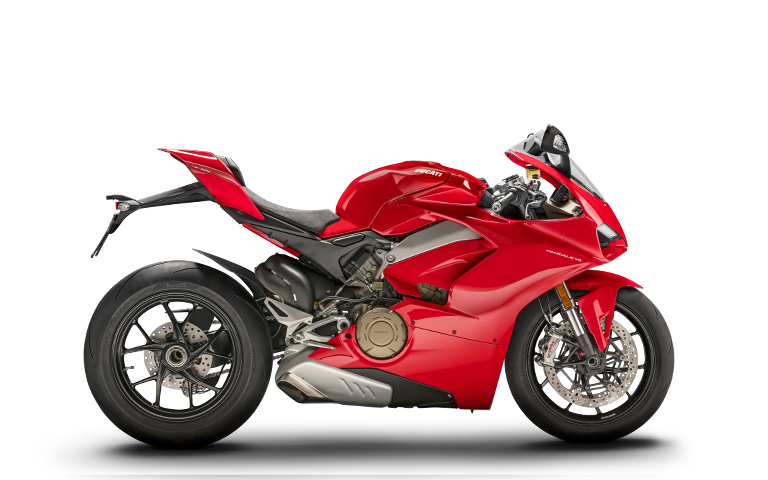
WHEELBASE 1.464 mm (57.64 in)
SEAT HEIGHT830 mm (32.48 in)
SEAT HEIGHT830 mm (32.48 in)
POWER;214 hp (157.5 kW)
TORQUE;124.0 Nm (91.5 lb-ft)
DRY WEIGHT;175 kg (386 lb)
SAFETY;Cornering ABS EVO, DTC EVO, DWC EVO,
PANIGALE 1409 S
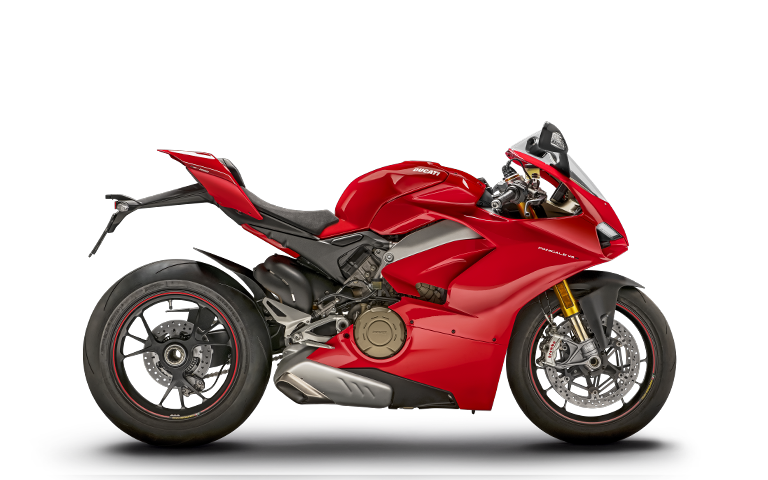
WHEELBASE;1.464 mm (57.64 in)
SEAT HEIGHT;830 MM (32.48 IN
POWER;214 hp (157.5 kW)
TORQUE;124.0 Nm (91.5 lb-ft)
DRY WEIGHT;174 kg (384 lb)
SAFETY;Cornering ABS EVO, DTC EVO, DWC EVO,
PANIGALE 1409 SPECIALE

WHEELBASE;1.464 mm
SEAT HEIGHT;830 MM
POWER;226 hp
TORQUE;124.0 Nm (91.5 lb-ft)
DRY WEIGHT;173 kg (381 lb)
SAFETY;Cornering ABS EVO, DTC EVO, DWC EVO,
Shaped by the Wind
The aerodinamic shape of the new Panigale V4 has been perfectioned in the wind tunnel, according to the best available technologies.
New Brembo Stylema®
When you share the same values of performance, design, technology and passion it is easy to be created synergy. This explains the durable bond that joins Ducati Brembo.
When we started designing the new Panigale V4 involved our historical suppliers of components, including Brembo.
Just at that time he was working on Brembo Stylema®, a new clamp OE, in his revolutionary way to improve the already excellent characteristics of Brembo calipers.
"Stylema® is the best caliper of the first plant ever produced by Brembo. The benefits that guarantees are so important that we wanted to associate them with an excellent super sports bikes. It served a revolutionary motorcycle, which will be discussed for years to come. We found her in the Panigale V4 and are proud to have contributed to its realization " Paolo Magri - Director Business Unit Moto.Stylema® is an aluminum caliper with four pistons (30 mm diameter) and 100 mm wheelbase that makes it possible to ensure the braking of Panigale V4 of lightness, performance, consistency of performance that enhance the sportiness and design.
Just at that time he was working on Brembo Stylema®, a new clamp OE, in his revolutionary way to improve the already excellent characteristics of Brembo calipers.
"Stylema® is the best caliper of the first plant ever produced by Brembo. The benefits that guarantees are so important that we wanted to associate them with an excellent super sports bikes. It served a revolutionary motorcycle, which will be discussed for years to come. We found her in the Panigale V4 and are proud to have contributed to its realization " Paolo Magri - Director Business Unit Moto.Stylema® is an aluminum caliper with four pistons (30 mm diameter) and 100 mm wheelbase that makes it possible to ensure the braking of Panigale V4 of lightness, performance, consistency of performance that enhance the sportiness and design.
New Pirelli DIABLO™ Supercorsa SP

Ducati and Pirelli worked hand in hand to develop the new Panigale V4, the first motorcycle ever to feature as factory equipment the new Pirelli DIABLO™ Supercorsa SP 120/70 ZR17 at the front and the revolutionary size 200/60 ZR 17 at the rear. The latest version of the DIABLO™ Supercorsa SP, in the new 200/60 ZR 17 size already popular as a slick option in the FIM World Superbike Championship, is a pioneer in the field of racing replica tyres. The innovative profile of the resized rear tyre maximises the contact patch at extreme lean angles and makes the most of the bi-compound technology used: the SC2 compound used for the shoulder area is the same used for racing slick products, ensuring the enhanced grip of racing tyres while guaranteeing at the same time the strength and versatility needed for road use.
In order to work in perfect harmony with the rear tyre, the front tyre has gone through an extra, major development step: all the riding items related to handling, from rider feedback through support solidity to safety feeling and grip loss predictability, have been optimised by creating a new front profile, slightly increased in terms of maximum section width with respect to the previous version of the product. Redesigning the geometries of the semi-finished products and the belt pattern has made it possible to set new agility and rideability standards, with at the same time top racing level performance. Finally, the new tread pattern of the DIABLO™ Supercorsa SP features a new "flash" geometry to optimise track performance by improving wear, and reduced groove widths designed to provide adequate support for strongerside thrusts side thrusts.
.


















#teamPXT






















































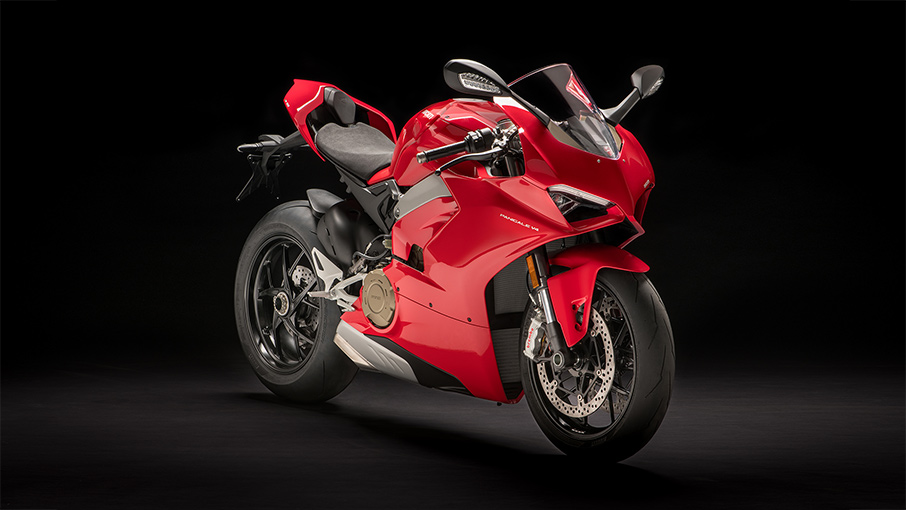
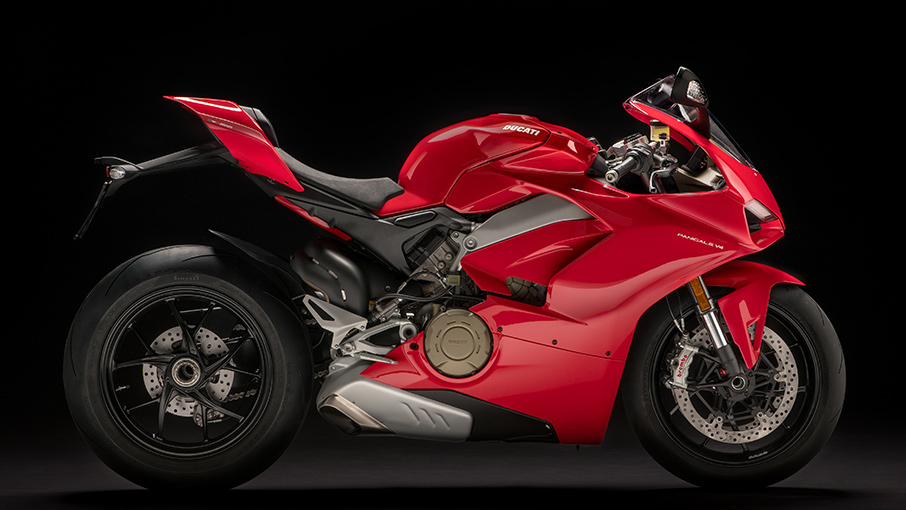

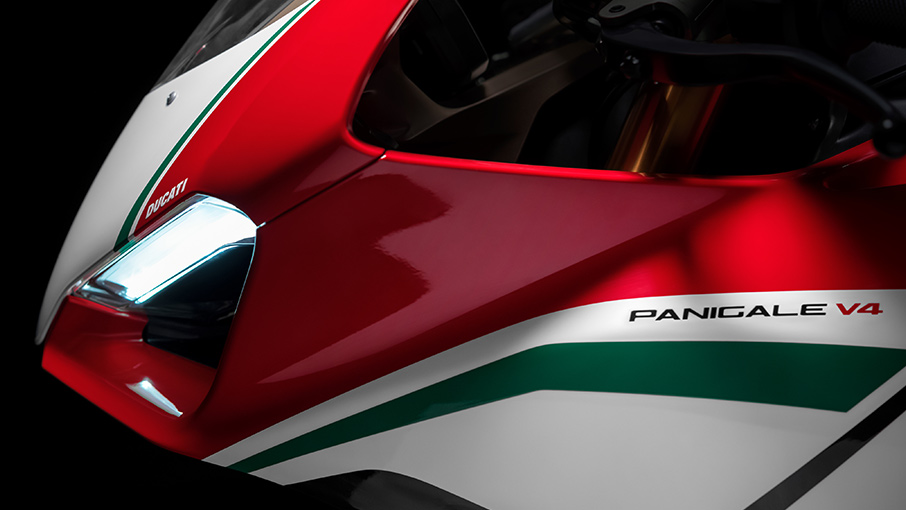


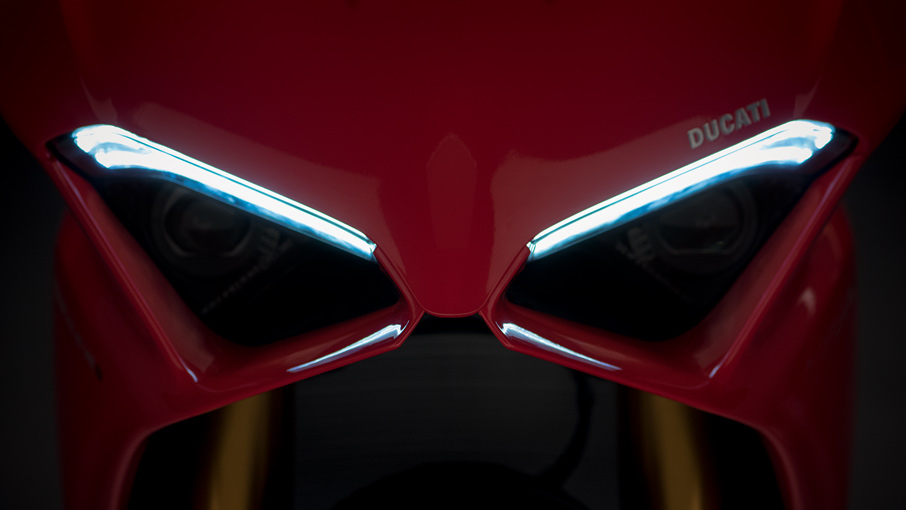

If you have any doubts, Please let me know ConversionConversion EmoticonEmoticon